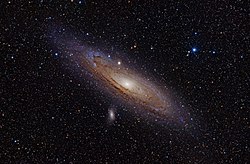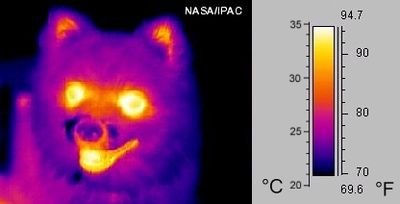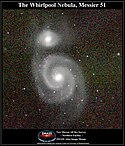Andromeda galaxy Ssc2005-20a1
This Spitzer's 24-micron mosaic is the sharpest image ever taken of the dust in another spiral galaxy. This is possible because Andromeda is a close neighbor to the Milky Way at a mere 2.5 million light-years away.
The Spitzer multiband imaging photometer's 24-micron detector recorded 11,000 separate snapshots to create this new comprehensive picture. Asymmetrical features are seen in the prominent ring of star formation. The ring appears to be split into two pieces, forming the hole to the lower right. These features may have been caused by interactions with satellite galaxies around Andromeda as they plunge through its disk.
Spitzer also reveals delicate tracings of spiral arms within this ring that reach into the very center of the galaxy. One sees a scattering of stars within Andromeda, but only select stars that are wrapped in envelopes of dust light up at infrared wavelengths.
This is a dramatic contrast to the traditional view at visible wavelengths, which shows the starlight instead of the dust. The center of the galaxy in this view is dominated by a large bulge that overwhelms the inner spirals seen in dust. The dust lanes are faintly visible in places, but only where they can be seen in silhouette against background stars.
The data were taken on August 25, 2004, the one-year anniversary of the launch of the space telescope. The observations have been transformed into this remarkable gift from Spitzer -- the most detailed infrared image of the spectacular galaxy to date.Relevante Bilder
Relevante Artikel
Liste der Satellitengalaxien von AndromedaDie Andromedagalaxie M31 besitzt genau wie unsere Heimatgalaxie die Milchstraße auch Satellitengalaxien. Derzeit sind mindestens 37 Galaxien bekannt, Andromeda eingeschlossen, die zusammen die Andromeda-Untergruppe der Lokalen Gruppe bilden.Unter ihnen sind auch Galaxien wie die elliptische Galaxie M32, die bereits mit kleineren Hobby-Teleskopen ausgemacht werden können. Die zweithellste Galaxie direkt in Nachbarschaft zu ihr ist M110. NGC 185 wurde am 30. November 1787 von Friedrich Wilhelm Herschel, die Zwerggalaxie NGC 147 von dessen Sohn John Frederick William Herschel am 8. September 1829 entdeckt. .. weiterlesen
InfrarotstrahlungInfrarotstrahlung ist in der Physik elektromagnetische Strahlung im Spektralbereich zwischen sichtbarem Licht und der längerwelligen Terahertzstrahlung. Üblicherweise ist damit Licht (i. w. S.) mit einer Wellenlänge zwischen 780 nm und 1 mm gemeint. Dies entspricht einem Frequenzbereich von 300 GHz bis 400 THz bzw. einem Wellenzahlbereich von 10 cm−1 bis 12.800 cm−1. Sie bildet die Grundlage von Anwendungen zum Beispiel in der Thermografie, Fernerkundung, bei Fernbedienungen und Nachtsichtgeräten. .. weiterlesen
InfrarotastronomieDie Infrarotastronomie ist ein experimenteller Teilbereich der Astronomie, der die von astronomischen Objekten ausgesandte Infrarotstrahlung nutzt. Diese Strahlung liegt in einem Teil des elektromagnetischen Spektrums, der vom menschlichen Auge nicht wahrgenommen werden kann. .. weiterlesen






















